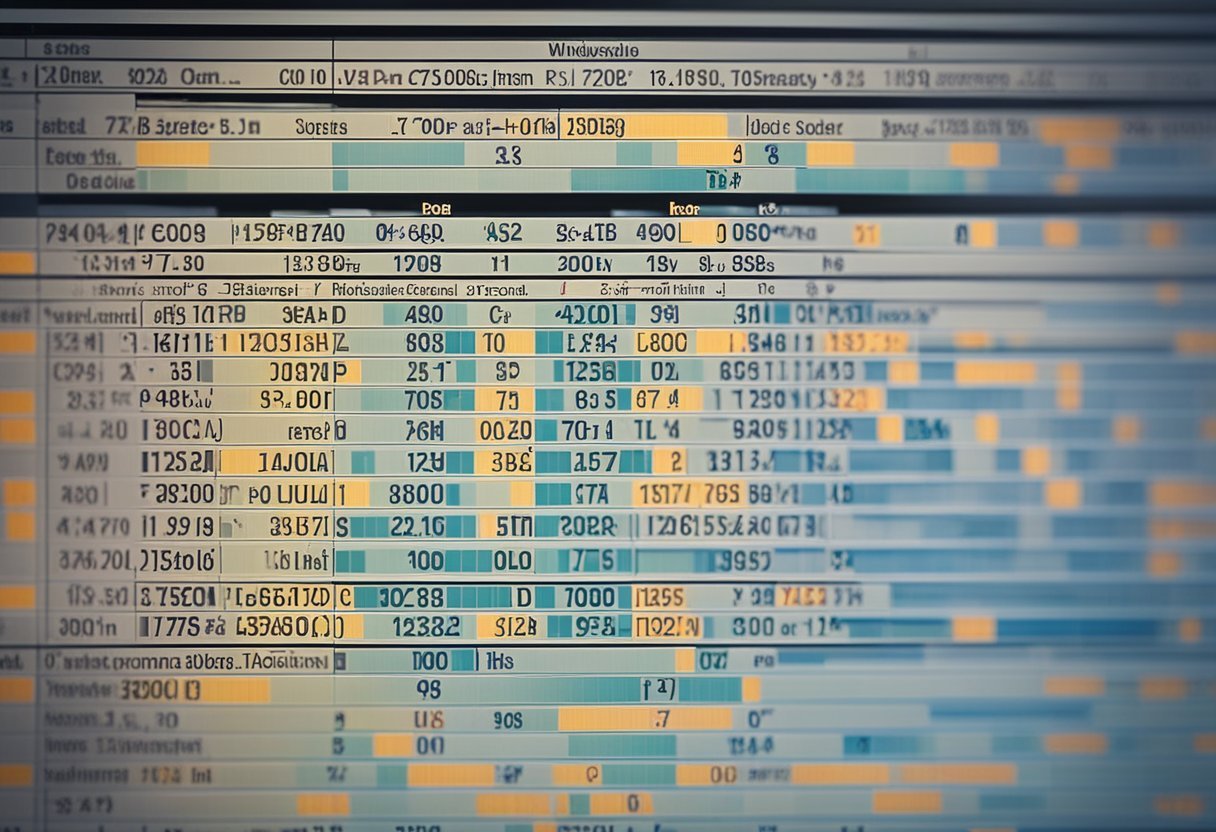Understanding Window Functions in SQL
Window functions in SQL are a powerful feature used for data analysis. These functions allow users to perform calculations across a specified range of rows related to the current row, without collapsing the data into a single result as with aggregate functions.
What Are Window Functions?
Window functions provide the ability to calculate values over a set of rows and return a single value for each row. Unlike aggregate functions, which group rows, window functions do not alter the number of rows returned.
This capability makes them ideal for tasks like calculating running totals or ranking data. A window function involves a windowing clause that defines the subset of data for the function to operate on, such as rows before and after the current row.
Window functions are typically used in analytical scenarios where it is necessary to perform operations like lead or lag, rank items, or calculate the moving average. Understanding these functions allows for more sophisticated data queries and insights.
Types of Window Functions
SQL window functions encompass several categories, including ranking functions, aggregation functions, and value functions.
Ranking functions like RANK(), DENSE_RANK(), and ROW_NUMBER() allow users to assign a rank to each row based on a specified order. Aggregation functions within windows, such as SUM() or AVG(), apply calculations over the specified data window, retaining all individual rows.
Analytical functions like LEAD() and LAG() provide access to different row values within the specified window. These functions are crucial for comparative analyses, such as looking at previous and next values without self-joining tables. For comprehensive guides to window functions, LearnSQL.com’s blog offers detailed resources.
Essentials of the PERCENT_RANK Function
The PERCENT_RANK function in SQL is crucial for determining the relative rank of a row within a data set. It provides a percentile ranking, which helps understand how a specific row stands compared to others. This function is particularly useful in data analysis and decision-making.
Syntax and Parameters
The syntax for the PERCENT_RANK() function is straightforward. It is a window function and is used with the OVER() clause. Here’s the basic syntax:
PERCENT_RANK() OVER (PARTITION BY expr1, expr2 ORDER BY expr3)
-
PARTITION BY: This clause divides the data set into partitions. The function calculates the rank within each partition.
-
ORDER BY: This clause determines the order of data points within each partition. The ranking is calculated based on this order.
The function returns a decimal number between 0 and 1. The first row in any partition always has a value of 0. This indicates its relative position as the lowest rank.
Calculating Relative Rank with PERCENT_RANK
Calculating the relative rank involves determining the position of a row among others in its partition. The calculation is straightforward:
- For N rows in a partition, the percent rank of row R is calculated as (R – 1) / (N – 1).
For example, with 8 rows in a partition, the second row has a PERCENT_RANK() of (2-1)/(8-1), which is 0.142857.
In practical terms, if a data set describes sales data, using PERCENT_RANK helps identify top and bottom performers relative to the rest, making it an effective tool for comparative analysis. This function also sheds light on how evenly data is distributed across different classifications or categories.
Working with the CUME_DIST Function
The CUME_DIST function is a powerful statistical tool in SQL, used to compute the cumulative distribution of a value within a set of values. It is commonly applied in data analysis to evaluate the relative standing of a value in a dataset. By using CUME_DIST, analysts can uncover insights about data distribution patterns and rank values accordingly.
Understanding Cumulative Distribution
Cumulative distribution is a method that helps in understanding how values spread within a dataset. The CUME_DIST function calculates this by determining the proportion of rows with values less than or equal to a given value out of the total rows. The result is a number between just above 0 and 1.
Unlike simple ranking functions, CUME_DIST considers the entire data distribution and provides a continuous metric. This is particularly useful when you need to assess not just the rank, but also the distribution of values, making it easier to compare similar data points.
In databases, the CUME_DIST function is implemented through window functions, allowing for dynamic analysis and reporting.
Application of CUME_DIST in Data Analysis
In data analysis, CUME_DIST is crucial for tasks such as identifying percentiles and analyzing sales performance.
For instance, if an analyst wants to identify the top 20% of sales performers, they can use CUME_DIST to determine these thresholds. The function works by ranking sales figures and showing where each figure falls in the overall dataset.
Furthermore, CUME_DIST is essential when working with large datasets that require a clear view of data distribution. It allows analysts to make informed decisions by seeing the proportion of data that falls below certain values. This makes it a staple in statistical reporting in various fields like finance, marketing, and operations, as indicated in tutorials on SQL window functions.
Exploring Ranking Functions in SQL
Ranking functions in SQL help in sorting data and managing sequence numbers. Understanding these functions, such as RANK, DENSE_RANK, and ROW_NUMBER, can enable more sophisticated data analysis and reporting.
The Rank Function and Its Variants
The RANK function assigns a unique rank to each row within a partition of a result set. The key feature to note is that it can produce gaps in ranking if there are duplicate values.
For instance, if two rows tie for the same rank, the next rank will skip a number, leaving a gap.
On the other hand, the DENSE_RANK function does not leave gaps between ranks when duplicates occur. It sequentially assigns numbers without skipping any.
The ROW_NUMBER function, on the other hand, gives a unique sequential number starting from one, without regard to duplicate values. This helps in pagination where each row needs a distinct number.
NTILE is another variant, which divides the data into a specified number of groups and assigns a number to each row according to which group it falls into.
Practical Examples of Ranking Functions
Consider a situation where a company wants to rank salespeople based on sales figures. Using RANK(), ties will cause gaps in the listing.
For example, if two employees have the same sales amount, they both receive the same rank and the next rank skips a number.
The use of DENSE_RANK() in the same scenario will not allow any gaps, as it assigns consecutive numbers even to tied sales amounts.
Implementing ROW_NUMBER() ensures each salesperson has a unique position, which is useful for exporting data or displaying results in a paginated report.
These functions bring flexibility in sorting and displaying data in SQL and help in carrying out detailed analytical queries, especially with large datasets.
Analyzing Partitioning with PARTITION BY

Understanding how to use the PARTITION BY clause in SQL is crucial for maximizing the efficiency of window functions such as RANK, PERCENT_RANK, and CUME_DIST. By defining partitions, users can perform complex calculations on subsets of data within a larger dataset, enabling more precise analysis and reporting.
Partitioning Data for Windowed Calculations
The PARTITION BY clause in SQL allows users to divide a result set into smaller chunks or partitions. By doing this, functions like PERCENT_RANK and CUME_DIST can be computed within each partition independently. This approach ensures that the calculations are relevant to the specified criteria and context.
Using PARTITION BY makes it possible to apply window functions that need data segregation while preserving the ability to analyze the entire dataset as needed.
For example, to rank sales data for each region separately, one can use PARTITION BY region to calculate rankings within each regional group. This ensures more accurate results by avoiding cross-group interference.
How PARTITION BY Affects Ranking and Distribution
The partitioning impacts the way RANK, PERCENT_RANK, and CUME_DIST functions are applied. By setting partitions, these functions generate their results only within each partition’s limits, allowing for an isolated calculation in a large data environment.
For instance, when PERCENT_RANK is combined with PARTITION BY, it calculates the percentage ranking of a row in relation to other rows just within its group. This behavior provides valuable insights, particularly when each group must maintain its independent ranking system.
Similarly, CUME_DIST calculates the cumulative distribution of values within the partition, assisting in precise trend analysis without losing sight of individual row details. By applying PARTITION BY, SQL users can ensure that these analytical functions respect and reflect the logical groupings necessary for accurate data interpretation.
Advanced Usage of Aggregate Window Functions
Aggregate window functions in SQL provide powerful ways to calculate various metrics across data sets while still retaining the granularity at the row level. This approach allows users to perform detailed analysis without losing sight of individual data points.
Combining Aggregate and Window Functions
Combining aggregate functions with window functions allows complex data analysis like computing rolling averages or cumulative totals without grouping the data. This is helpful in scenarios where individual data points must be preserved alongside summary statistics.
A common application is using the SUM function alongside OVER(PARTITION BY...) to calculate a running total within partitions of data. For instance, a cumulative sales total per department can be computed while still displaying each sale.
These powerful combinations can provide deeper insights, such as detecting emerging trends and anomalies in specific categories.
Performance Considerations
While aggregate window functions are versatile, they may impact performance, especially with large data sets. The performance of SQL queries involving these functions can vary based on data size and database structure.
Optimizing involves ensuring that appropriate indexes exist on the columns used in the PARTITION BY and ORDER BY clauses.
Reducing the data set size by filtering unnecessary rows before applying window functions can also enhance performance. Additionally, it’s crucial to monitor query execution plans to identify bottlenecks and optimize accordingly.
Efficient use of resources can lead to faster query execution and better responsiveness, even in complex queries.
Understanding Percentiles in Data Analysis
Percentiles are crucial in data analysis for understanding the position of a specific value within a dataset. This section explores the PERCENTILE_CONT and PERCENTILE_DISC functions, which are essential for calculating percentiles such as the median.
The Role of PERCENTILE_CONT and PERCENTILE_DISC Functions
In data analysis, percentiles help determine the relative standing of a value.
The PERCENTILE_CONT function calculates a continuous percentile, which includes interpolating between data points. This is useful when the exact percentile lies between two values.
PERCENTILE_DISC, on the other hand, identifies the nearest rank to a specific percentile, using discrete values. It chooses an actual value from the dataset without interpolation, making it helpful for categorical data or when precision isn’t critical.
Both functions are vital for deriving insights from data by allowing analysts to determine distribution thresholds. By using them, organizations can assess performance, identify trends, and tailor strategies based on how their data is distributed.
Calculating Median and Other Percentiles
The median is a specific percentile, sitting at the 50th percentile of a dataset.
Using PERCENTILE_CONT, analysts can find an interpolated median, which often provides a more accurate measure, especially with skewed data.
For a discrete median, PERCENTILE_DISC might be used, particularly in datasets where integer values are important.
Beyond the median, these functions allow calculating other key percentiles like the 25th or 75th.
Understanding the median and other percentiles offers deeper insights into data distribution.
It informs decision-making by highlighting not just averages but variations and anomalies within the data.
For more on these functions, PERCENTILE_CONT and PERCENTILE_DISC allow efficient calculation of percentiles in various data contexts, as shown in SQL Server analysis at PERCENTILE_DISC and PERCENTILE_CONT.
Incorporating ORDER BY in Window Functions

ORDER BY is vital in SQL window functions as it determines how data is processed and results are calculated.
This section explores how ORDER BY defines the sequence for data calculations and its usage with ranking functions.
How ORDER BY Defines Data Calculation Order
In SQL, the ORDER BY clause specifies the sequence of rows over which window functions operate.
This is crucial, especially in calculations like cumulative totals or running averages.
By ordering the data, SQL ensures that functions like SUM or AVG process rows in a defined order, producing accurate results.
Without this sequence, calculations might apply to unordered data, leading to unreliable outcomes.
Ordering affects functions such as PERCENT_RANK and CUME_DIST, which require specific data sequences to evaluate positions or distributions within a dataset.
These functions return results based on how rows are ordered.
For instance, when calculating the percentile, ORDER BY ensures values are ranked correctly, offering meaningful insights into data distribution.
This makes ORDER BY an essential element in many SQL queries involving window functions.
Utilizing ORDER BY with Ranking Functions
Ranking functions like RANK, DENSE_RANK, and PERCENT_RANK heavily depend on ORDER BY to assign ranks to rows.
ORDER BY defines how ties are handled and ranks are assigned.
In RANK and DENSE_RANK, the ordering determines how rows with equal values are treated, affecting the sequence and presence of gaps between ranks.
When ORDER BY is used with PERCENT_RANK, it calculates a row’s relative position by considering the ordered row sequence.
For CUME_DIST, ORDER BY helps determine the cumulative distribution of a value within a dataset.
By ordering correctly, these functions accurately represent data relationships and distributions, making ORDER BY indispensable in comprehensive data analysis.
Leveraging T-SQL for Windowed Statistical Calculations

T-SQL offers powerful tools for handling complex data analysis needs through window functions.
These functions are crucial in performing advanced statistical calculations in SQL Server, especially when dealing with large datasets in SQL Server 2019.
Specifics of Window Functions in T-SQL
T-SQL’s window functions provide a way to perform calculations across a set of table rows that are related to the current row.
They use the OVER clause to define a window or a subset of rows for the function to operate within.
A common use is calculating statistical functions like PERCENT_RANK and CUME_DIST.
These functions help in determining the rank or distribution of values within a specific partition of data.
- PERCENT_RANK computes the rank of a row as a percentage of the total rows.
- CUME_DIST calculates the cumulative distribution, providing insight into how a row’s value relates to the rest.
Understanding these functions can significantly improve your ability to perform detailed data analysis in SQL Server.
Optimizing T-SQL Window Functions
Optimization is key when handling large datasets with T-SQL window functions.
Several strategies can enhance performance, especially in SQL Server 2019.
Using indexes effectively is crucial. By indexing columns involved in window functions, query performance can be substantially improved.
Partitioning large datasets can also enhance efficiency. It allows window functions to process only relevant portions of the data.
Moreover, understanding execution plans can help identify bottlenecks within queries, allowing for targeted optimizations.
Utilizing features like filtered indexes and the right join operations can also contribute to faster query responses.
These approaches ensure that T-SQL window functions are used efficiently, making them robust tools for statistical calculations.
Exploring SQL Server and Window Functions
SQL Server provides a powerful set of window functions to analyze data, offering unique ways to compute results across rows related to the current row.
Focusing on ranking window functions, these techniques are vital for complex data analysis.
SQL Server’s Implementation of Window Functions
SQL Server, including versions like SQL Server 2019, supports a variety of window functions.
These functions perform calculations across a set of table rows related to the current row. They are essential for executing tasks like calculating moving averages or rankings without altering the dataset.
The RANK and DENSE_RANK functions allocate ranks to rows within a query result set. The ROW_NUMBER function provides a unique number to rows.
Functions like PERCENT_RANK and CUME_DIST are more advanced, offering percentile distributions of values. CUME_DIST calculates the relative standing of a value in a dataset.
Best Practices for Using Window Functions in SQL Server
When using window functions in SQL Server, performance and accuracy are crucial.
It’s essential to use indexing to speed up queries, especially when dealing with large datasets.
Writing efficient queries using the correct functions like PERCENT_RANK can improve the calculation of ranks by avoiding unnecessary computations.
Ensure that the partitioning and ordering clauses are used properly. This setup allows for precise control over how the calculations are applied.
Consider the data types and the size of the dataset to optimize performance.
Properly leveraging these functions allows for creative solutions to complex problems, such as analyzing sales data trends or ranking students by grades.
Frequently Asked Questions
Understanding PERCENT_RANK and CUME_DIST functions can be crucial in statistical data analysis. Each function offers unique capabilities for data ranking and distribution analysis, and they can be implemented in various SQL environments.
What are the primary differences between CUME_DIST and PERCENT_RANK functions in SQL?
The main difference is how they calculate rankings.
CUME_DIST determines the percentage of values less than or equal to a given value, meaning it includes the current value in its calculation. Meanwhile, PERCENT_RANK calculates the percentile rank of a row as the fraction of rows below it, excluding itself.
More details can be found in an article on CUME_DIST vs PERCENT_RANK.
How do you use the PERCENT_RANK window function within an Oracle SQL query?
To use PERCENT_RANK in Oracle SQL, the syntax PERCENT_RANK() OVER (PARTITION BY expr1 ORDER BY expr2) is typically utilized. This command allows users to calculate the position of a row within a partitioned result set.
More examples of PERCENT_RANK can be explored in SQL tutorials.
Can you explain how to implement CUME_DIST as a window function in a statistical analysis?
CUME_DIST can be executed using the syntax CUME_DIST() OVER (ORDER BY column) in SQL queries. This function gives the cumulative distribution of a value, expressing the percentage of partition values less than or equal to the current value.
Detailed explorations can be a valuable resource when delving into statistical analysis methods.
In what scenarios would you use NTILE versus PERCENT_RANK for ranking data?
While PERCENT_RANK is used for calculating the relative rank of a row within a group, NTILE is employed for distributing rows into a specified number of roughly equal groups.
NTILE is beneficial when organizing data into specific percentile groups and is ideal for creating quartiles or deciles.
What is a window function in the context of statistical analysis, and how is it applied?
Window functions perform calculations across a set of rows related to the current query row.
They enable complex data analysis without the need for additional joins.
Used in statistical analysis, they can compare and rank data within defined windows or partitions in a data set, providing insights into trends and patterns.
Could you provide an example of using the PERCENT_RANK function in a Presto database?
In Presto, PERCENT_RANK can be implemented in a SQL query with the syntax PERCENT_RANK() OVER (PARTITION BY column ORDER BY value).
This facilitates ranking rows within a partition. For practical applications, consider reviewing SQL resources that focus on Presto database environments.
